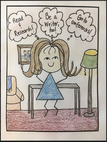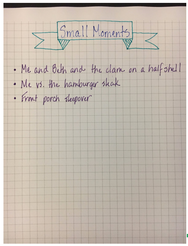
According to author and psychiatrist Elisabeth Kubler-Ross "There are only two emotions: love and fear. All positive emotions come from love, all negative emotions from fear." She also believed that these two emotions are mutually exclusive, that we cannot live in a state of fear and love at the same time.
Is it possible, as suggested by Kubler-Ross's theory, that all of the negative energy that flows around writing instruction in our classrooms may actually stem from fear?
Whoa! What? Hold on a minute!
Let's flip this thinking around right now and, instead, consider how we might create positive energy around writing instruction in our classrooms by learning to LOVE the process, LOVE the product, and LOVE the community that grows when everyone is a writer!
As an elementary literacy support specialist in my district, I conduct a lot of professional learning sessions in August. One line that I uttered at many of these sessions got a big laugh every single time - "You only have to be a little bit better writer than your students." When I said this, teachers could breathe, relax, and let go of the fear of not being confident as writing teachers. They smiled, looked at each other, and I could practically see the negative energy leave the room.
Love conquers Fear!
Remember last time I talked about making picture books? Let's begin to build our love for everything writing by authoring a picture book. This genre is appropriate to teach writing to all levels of students because all children are familiar with the structure of a picture book. And, so are all teachers! We can call on this very familiar context to be the foundation for our first writing experience, much like we do for our pre-K and kindergarten students.
I'm using the analogy of swimming for our writing lessons. Being comfortable in any body of water is scary for lots of people; and water has a metaphorical vibe for being an "unknown". So, we will start with what I call Deep Dives. These are the simple truths about what we are learning. We anchor all of the strategies of writing on the Deep Dives.
Generating Ideas - The "I Don't Have Anything To Write About" Fear
Deep Dives:
- Deep Dive#1 Writing is storytelling: When we write personal narratives, we are telling stories about our lives. Let's think about story.
- Things happen -
- Action/Events
- There are characters -
- Who say things.
- Who do things.
- Things happen in sequence -
- Beginning
- Middle
- End
- Things happen -
- Deep Dive #2 Writers get ideas from their own lives: Writers get ideas from their own lives,
- BUT, sometimes writers have a hard time thinking of ideas,
- SO, we read books to spark ideas.
- Mentor texts can give us a jumping off point, inspiring us to consider something that happened in our lives that could be interesting to a reader.
- ToeDip - Thinking of Ideas
- Read Fireflies!, by Julie Brinkloe (or find it read aloud on YouTube if you don't have a copy on hand) and
- Think about the specific kinds of things you did when you were a kid, like catching fireflies in the evening.
- Remember those small moments of your childhood that were part of how you grew up.
- Take out your sketchbook/writer's notebook and turn to a clean page. Make a list of at least 3 small moments in your childhood that you can remember with some detail.
- Read Fireflies!, by Julie Brinkloe (or find it read aloud on YouTube if you don't have a copy on hand) and
Next time, we will think about which of our small moments we want to expand into a full narrative. I want to thank Lucy Calkins and all of the great work that has come out of Teachers College at Columbia University for the foundational thinking I am sharing with you. She inspired my love of writing, love that replaced fear, which has, in turn, inspired hundreds of my students to love writing as well.
I hope you are inspired to love writing, too! Have a great writing week!
#allkidscanwrite
#allteacherscanwrite

 RSS Feed
RSS Feed
